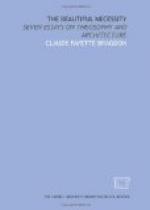[Illustration 86]
Seven is proverbially the perfect number. It is of a quantity sufficiently complex to stimulate the eye to resolve it, and yet so simple that it can be analyzed at a glance; as a center with two equal sides, it is possessed of symmetry, and as the sum of an odd and even number (3 and 4) it has vitality and variety. All these properties a work of architecture can variously reveal (Illustration 77). Fifteen, also, is a number of great perfection. It is possible to arrange the first 9 numbers in the form of a “magic” square so that the sum of each line, read vertically, horizontally or diagonally, will be 15. Thus:
4 9 2 = 15
3 5 7 = 15
8 1 6 = 15
— —
—
15 15 15
Its beauty is portrayed geometrically in the accompanying figure which expresses it, being 15 triangles in three groups of 5 (Illustration 86). Few arrangements of openings in a facade better satisfy the eye than three superimposed groups of five (Illustrations 76-80). May not one source of this satisfaction dwell in the intrinsic beauty of the number 15?
In conclusion, it is perhaps well that the reader be again reminded that these are the by-ways, and not the highways of architecture: that the highest beauty comes always, not from beautiful numbers, nor from likenesses to Nature’s eternal patterns of the world, but from utility, fitness, economy, and the perfect adaptation of means to ends. But along with this truth there goes another: that in every excellent work of architecture, in addition to its obvious and individual beauty, there dwells an esoteric and universal beauty, following as it does the archetypal pattern laid down by the Great Architect for the building of that temple which is the world wherein we dwell.
VII
FROZEN MUSIC
In the series of essays of which this is the final one, the author has undertaken to enforce the truth that evolution on any plane and on any scale proceeds according to certain laws which are in reality only ramifications of one ubiquitous and ever operative law; that this law registers itself in the thing evolved, leaving stamped thereon as it were fossil footprints by means of which it may be known. In the arts the creative spirit of man is at its freest and finest, and nowhere among the arts is it so free and so fine as in music. In music accordingly the universal law of becoming finds instant, direct and perfect self-expression; music voices the inner nature of the will-to-live in all its moods and moments; in it form, content, means and end are perfectly fused. It is this fact which gives validity to the before quoted saying that all of the arts “aspire toward the condition of music.” All aspire to express the law, but music, being least encumbered by the leaden burden of materiality, expresses it most easily and adequately. This being so there is nothing unreasonable in attempting to apply the known facts of musical harmony and rhythm to any other art, and since these essays concern themselves primarily with architecture, the final aspect in which that art will be presented here is as “frozen music”—ponderable form governed by musical law.




